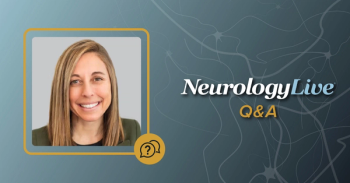
Plasma Tau Data on Aducanumab Point to Positive Effects on Cognition
Ivana Rubino, PhD, the head of Medical for Global Alzheimer at Biogen, offered her perspective on the recently presented data at CTAD 2021.
At the
The high-dose group data from EMERGE (n = 514-521) showed a 13% reduction from baseline in tau pathology that was associated with aducanumab treatment in a dose- and time-dependent fashion compared with placebo, which experienced an 8% rise (P <.001). ENGAGE’s high-dose group (n = 577-581) showed a p-tau reduction of 16% in the treatment group, compared with a 9% rise for placebo (P <.001). Additionally, a greater reduction in plasma p-tau181 was shown to be correlated with a lessened level of clinical decline in all 4 of the trials’ outcome measure (FIGURE).
To find out more about the clinical implications of these data, NeurlogyLive spoke with Ivana Rubino, PhD, Head of Medical, Global Alzheimer's, Biogen.
NeurologyLive: What do these data represent for you in terms of the understanding of the clinical benefit of aducanumab?
Ivana Rubino, PhD: When you look at the totality of the data that we have shared so far, we have seen that treating patients with the right dose of it can lead to a reduction of the amyloid pathology. But the other question is what the reduction of the amyloid pathology means in terms of downstream effects on the tau pathology and clinical decline—which is actually our ultimate goal delayed this is progression.
So far, we had seen the correlation between amyloid pathology reduction and tau pathology reduction in our PET substudy, and for tau in our CSF substudy. But the data we shared at CTAD are even more convincing, and so important because we're talking about the largest dataset to ever be analyzed for blood biomarkers: 7000 samples from 1800 patients. And once again, what you see is this those is time-dependent in terms of reduction of tau pathology, and this correlation with amyloid removal, and ultimately the change in clinical decline. When you look at this, it started giving us a picture of the targeting of amyloid as an approach, not just focusing on and limited to the removal of amyloid, but actually changing that the downstream pathologies, and leading up to the change in the clinical profile.
Now, the data especially created a good momentum at CTAD because we had seen, through the 3 days of the Congress, similar findings coming from all the drugs that have similarly targeted the amyloid pathology. Now, together, the evidence that we're presented with the aducanumab data yesterday, speaks about what we are learning about one of the antibodies targeting amyloid-ß, and—especially—we're talking almost about a new generation of monoclonal antibodies, and study design. Altogether, this evidence starts telling us that we can indeed intervene in 2 of the most critical pathologies in the brain for Alzheimer patients, being the amyloid pathology and the tau pathology.
All in all, of course, we are very enthusiastic, but also, we're thinking about what does it mean practically? With biomarkers in the blood, they've always been the holy grail for the Alzheimer community, we hope that there will be soon tests available for the real world. But in the meantime, these data represent and speak to how much progress we have made as a community and that, most likely, the near future will change and the way we manage these patients in the real world by means of introducing the blood biomarker as a screening tool, as a recruitment tool in the trials, but also artfully, as a monitoring tool for patients on treatment.
How do these data set the stage for the rest of the pipeline, and the upcoming additional members of this class?
I don't want to forget that Audhelm [aducanumab] is the only drug that has completed the test of phase 3 data, and our data set, as of now, is particularly large when you think about the ENGAGE and EMERGE data. But also, when you think about the EMBARK data set. I don't know if you saw the presentation about the EMBARK baseline data, because that's also particularly important that these data, all taken together, start speaking about couple of things.
One is when you think about the totality of the effect that you can get using a monoclonal antibody, you start creating a framework to assess treatment response that is a combination of biomarker and multiple clinical end points. I'm sure you're pretty familiar with our data on EMERGE, and the fact that we saw changes across all the domains of Alzheimer disease when patients were exposed to the highest dose of 10 mg/kg. But also, when you start looking at the totality of the data, including EMBARK, this Congress starts giving us as a community a lot to think about when we consider treatment duration. There are a lot of questions about for how long do we treat our patients? Do we just aim to remove the amyloid plaque and call that treatment success? Well, the data from aducanumab, but also the data for instance, from lecanemab, start speaking. First and foremost: the removal of amyloid plaque is one of the effects. But there is a little bit more that's happening in the brain, and that is the secondary effect on the tau pathology.
But especially when looking at the baseline data from EMBARK—while I cannot yet say how long is the right duration for treatment, I can certainly look at those data and tell you that discontinuing treatment only on the basis of reduction of amyloid plaque may not be the right answer yet, because we saw that while the amyloid plaque remained stable in the patients that were treated with a 10 mg/kg dose, actually, the clinical progression continues. So all in all, this starts saying that when you treat with these monoclonal antibodies, you are actually changing and affecting potentially more than one pathology, and therefore, the way how you decide to monitor for treatment duration needs to take into account all these multiple effects that the therapy is having on the on this very complex pathology.
Do you think that that seeing this effect on multiple pathologies by mediating amyloid, lends promise to the potential of combination approaches?
I have been in Alzheimer for too long—for much more than I want to admit because it gives away my age—but fundamentally, we've been talking about combination for decades. We're always saying that to start exploring combinations, we needed to have a first drug being approved. Now, we are at that point, and it was brilliant to first and foremost, I would encourage everyone to watch the presentation by Ronald C. Petersen, MD, PhD, who very nicely in his keynote speech, basically explained why despite knowing we have amyloid pathology and tau pathology, but we have many other pathologies that as of today, we cannot measure. The complexity of this disease is something that as a community we recognize, and that's why, of course, the next step for us is to keep investigating how to combine treatment.
There were a couple of announcements at CTAD from the DIAN-TU group and from the ATCT—they are starting to actually do combination trials. I'm very happy this is happening in a pretty competitive space because it will also start giving us a sense of what the treatment paradigm is in Alzheimer disease. I don't know exactly at this point. I could just speculate what combination looks like—whether it has a maintenance phase, whether it's inducing with one therapy and then following with the others, combining from the beginning—I don't know. I think those are all different questions we need to actually address. But the big thing for this community is that now we are in a position to be able to analyze pathologies. We went from knowing nothing to controlling amyloid, and now we can also monitor for tau pathology, and in the near future, make more progress with regard to further characterizing these patients.
Let's face it, Alzheimer is a disease that starts 20 years before people show symptoms. It's obvious that there is much more happening, and that's where I think the field is really moving. Understanding, almost at the patient level, what's really happening and how to best tackle that. So I think June 7, 2021, in this regard, really marks the beginning of a new era because having an approved drug with a mechanism that we know opens up for the opportunity to start exploring how to combine this mechanism with other mechanisms.
What should the clinical community take away from these data?
We are in a position, we are at the moment, in this community where we can have data-driven conversations. The aducanumab effect offers us an opportunity to really understand these patients, thanks to the size of the data set. If you just consider ENGAGE and EMERGE, we're talking about 3000 people overall in the program, who have been treated with aducanumab for well over 9 years. We have also data about the treatment-gap period.
What I hope the community, starts doing is looking at the data and thinking about how these data can help them and inform how they manage the patients in the real world. I hope they feel that this picture that we keep building with new data and how aducanumab’s mode of action on the amyloid plaques changes that downstream pathology becomes more and more clear as they think about what to expect when treating someone with it. And, how this actually correlates with the clinical changes that we saw across all the domains. I also hope they feel positive.
There is a newly found momentum for the Alzheimer community overall because it doesn't happen often in this community to see so much data directionally telling us that we are on the way, that we are on the right journey. Now, it's up to us to make sure that we continue and, especially, that we focus on giving access to drugs to the right patients.
Transcript edited for clarity.
REFERENCES
1. New Phase 3 Data Show Positive Correlation Between ADUHELM™ Treatment Effect on Biomarkers and Reduction in Clinical Decline in Alzheimer’s Disease. News release. Biogen. November 11, 2021. Accessed November 15, 2021. https://investors.biogen.com/news-releases/news-release-details/new-phase-3-data-show-positive-correlation-between-aduhelmtm
2. Hansson O, Nisenbaum L, Chen T, et al. Dose and time dependent changes in plasma p tau 181 in patients treated with aducanumab in the ENGAGE and EMERGE trials. Presented at: CTAD; November 9-12, 2021; Virtual & Boston, MA. Late Breaking Readout Roundtable.
Newsletter
Keep your finger on the pulse of neurology—subscribe to NeurologyLive for expert interviews, new data, and breakthrough treatment updates.



























